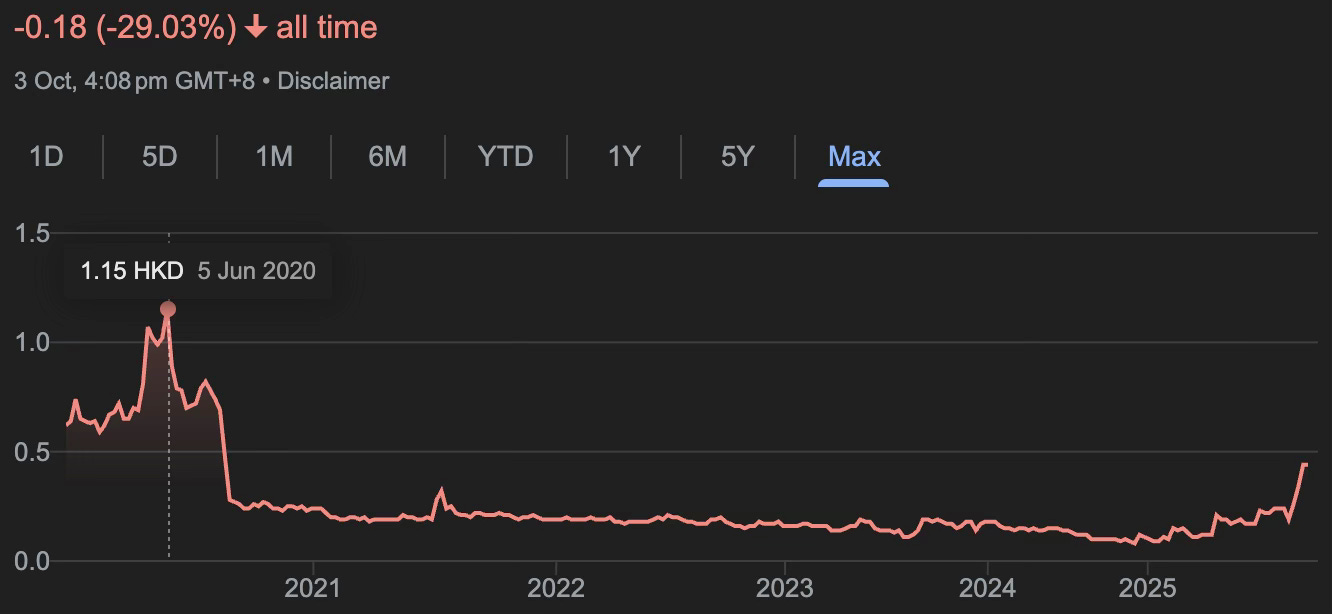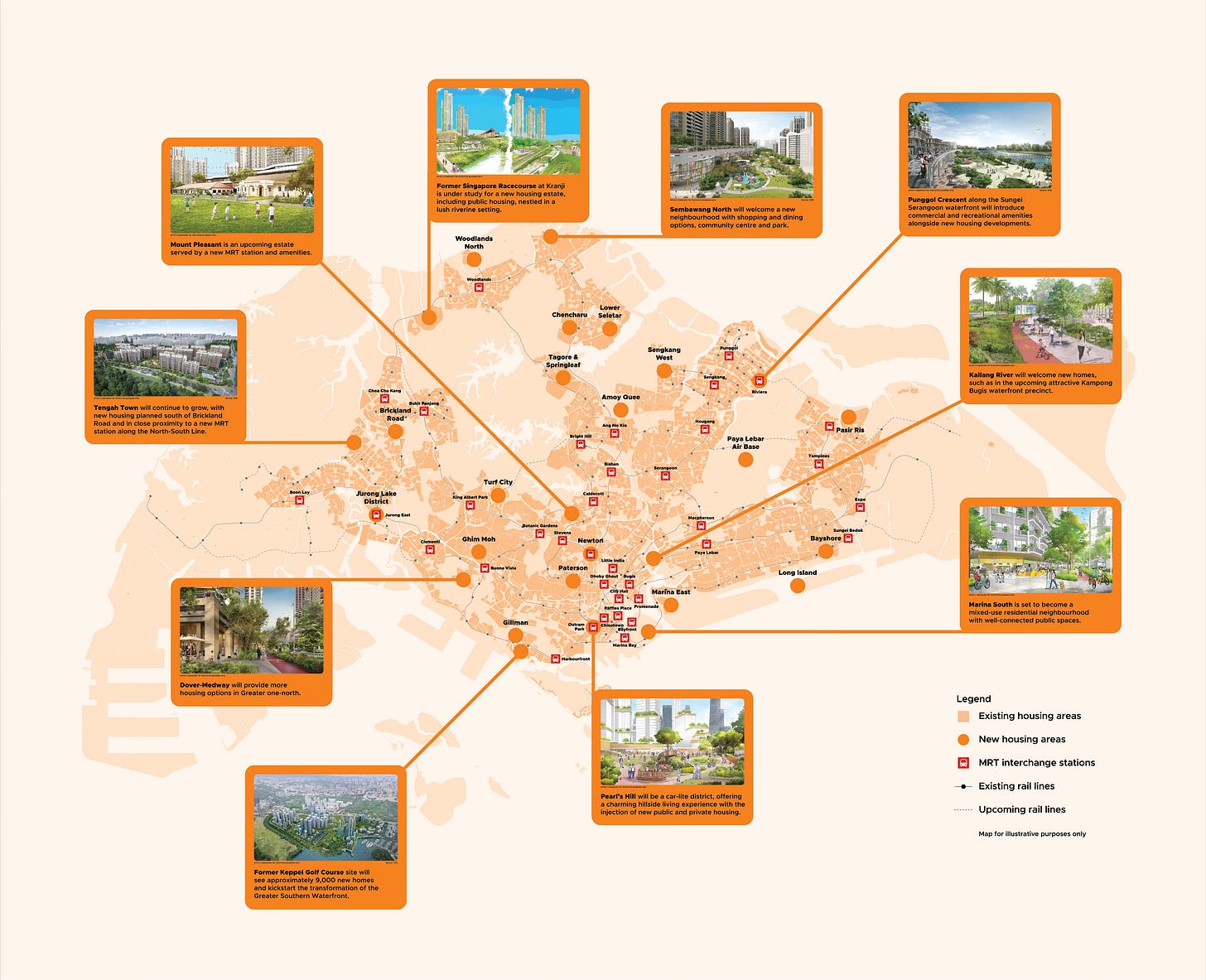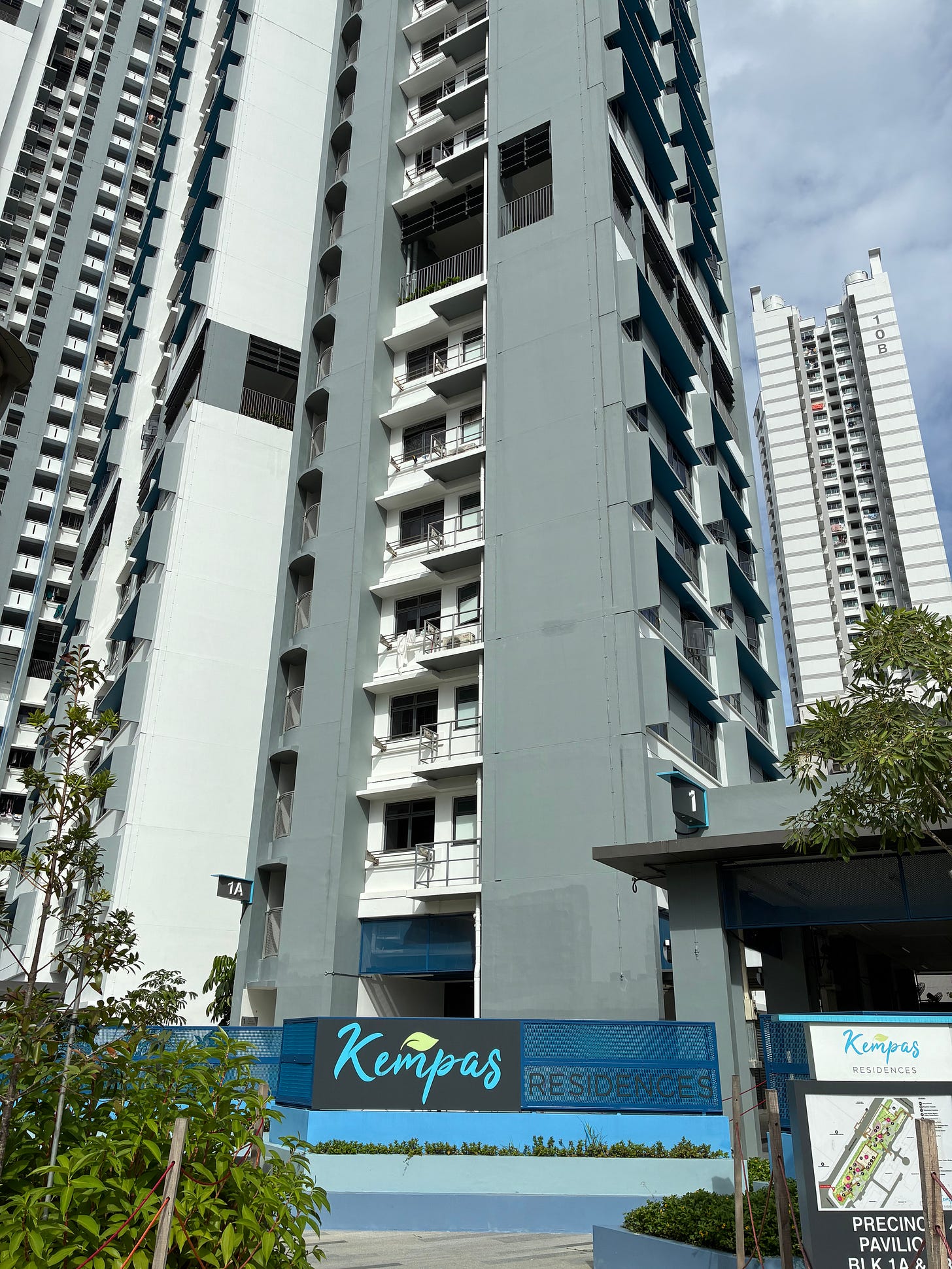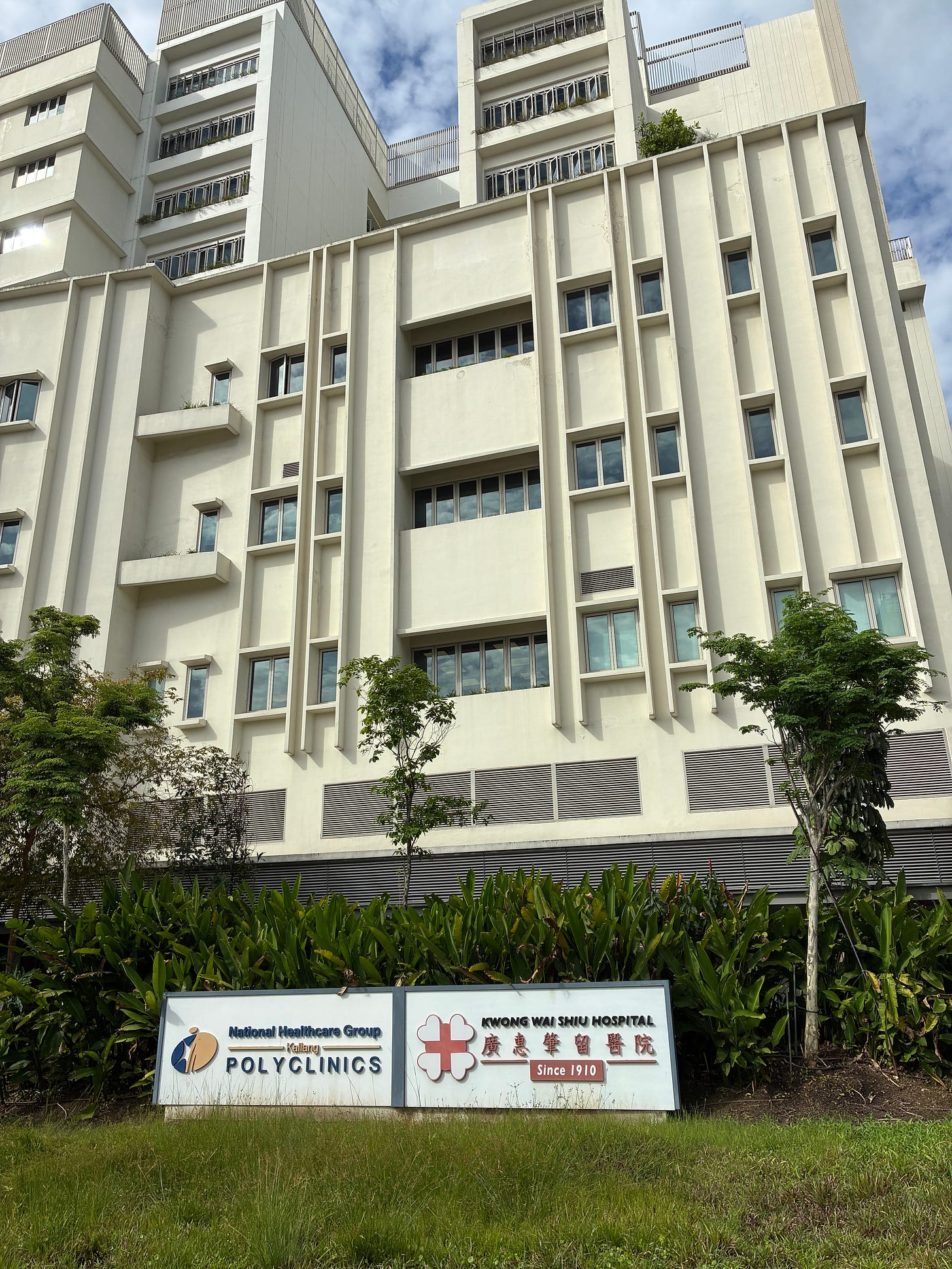My favourite Singapore construction play
<5 PE, S$93.7m cash, growing 19% next year, dividends, riding a decade long public sector construction boom
Update: This note previously stated that the order book was between S$630 to 650m. We now believe the actual number is closer to S$770m, because the company reported a S$151m contract win after the end of its financial year on 30 June 2025. We have also removed the paywall on 24 October 2025.
Kwan Yong Holdings is a pure1 Singapore construction play focused on building educational institutions and medical facilities and is making inroads into public housing. This focus synchronizes with a government plan to build 27 new residential hubs in the next 10 to 15 years.
In January 2020, KYH completed its listing on the HKSE at an offer price of HKD 0.65. It traded up to HKD 1.15 as the pandemic unfolded before postponed education and healthcare development plans in Singapore weighed on the company for several years. The company is now rerating back in the direction of its pre-pandemic high.
Today, KYH boasts record revenues (S$239.9m), order book (~S$770m) and EPS (S$0.016) and an improved financial position. According to the company’s latest results, it will recognize approximately 19% more revenue next financial year and has 2.5 years of visible earnings in its order book.
KYH’s valuation is superficially attractive relative to many well known favorites such as OKP Holdings, Soilbuild Construction and Huationg Global. However, there are many more reasons for liking this idea. This post will discuss the company’s customer concentration, track record, order book, tender book, Singapore’s development plans, and other points that struck me as distinguishing KYH from its peers.
A draft was circulated to paid subscribers and other supporters before publication, and while I benefitted from their input all errors are entirely my own. If you would like to receive these ideas before they are made public, upgrade to a paid subscription today. I also take calls with founding members to walk them through the thesis.
Note that you may not be able to invest through IBKR depending on your residency.
Let’s dive in.
Customer concentration
Ministry of Education: KYH has a longstanding relationship dating back to at least the mid-2000s. They have built quite a staggering number of schools, including for private sector clients. They are now redeveloping a junior college, contributing to a key MOE project.
Ministry of Health: KYH has a track record building nursing homes. They are continuing to tender successfully for these projects (~S$30-50m size) but are also moving into larger projects, such as the ongoing S$200m integrated polyclinic and nursing home contract.
Housing Development Board: Won an award for its first HDB project completed this year. Has two ongoing HDB projects and is tendering for several more.
On the flip side of this concentration:
These clients represent the biggest spending in Singapore’s budget (excluding defence).
The clients are extremely credit worthy.
The new HDB client is a breakthrough for them, demonstrating an ability to diversify into a different government arm / revenue stream.
KYH’s core competency in public sector institutional buildings is synchronized with the multi-year upswing in Singaporean government-led construction spend in housing and healthcare (the education boom might be more modest due to demographics).
It is refreshing to find a construction company not focused on industrials, roads or expensive private residences. KYH is weaving itself into the fabric of the country, building the places Singaporeans collect formative memories, live, and care for their aging parents. From the annual reports and news articles about the company, one gets the sense of a proud and responsible company who takes pride in their workmanship, punctuality, cost management, and safety record:
High construction quality scores in 2024, 2023, and 2022. This is known as the CONQUAS score in Singapore.
No liquidated damages in 2024 and 2023.
Low demerit points from the Ministry of Manpower.
No reported incidents of accidents or corruption. There is at least one glowing and articulate review from a new WSH officer online praising the commitment to safety. Another WSH officer (or possibly the same one) has won an award and has been regularly featured in the press.
KYH commissioned a piece in the Straits Times recently. This offers an insight into how the company sees itself or wishes to be seen.
Order book
The company has an order book of S$ 653.5 million comprising the following projects:
Sin Ming Residences (four block HDB project) - S$210.5m- from mid-2023 to Q2 2027
HDB upgrading project - S$39m - awarded in April 2023 - status unknown.
MOH east region nursing home - S$52m - from mid-2023 and close to completion.
MOH Jurong polyclinic and nursing home - S$201m - from August 2024 to 2028.
MOE Anderson junior college - S$151m - from July 2025 to January 2028.
[Update: There appears to be one or more additional unidentified ongoing projects]
It will recognize S$ 286.2m in revenue in FY 2026, 19% more than the record S$ 239.9m revenue achieved in FY 2025.
Tender book and pipeline
KYH’s revenue appears to be closely tied to the building of new towns or residential hubs. In that regard, this article offers an insight into what is coming in the pipeline. This map from the Urban Redevelopment Authority’s 2025 to 2035/40 masterplan suggests 27 new residential hubs (each orange circle is a new hub)
The URA masterplan is presented to the public in a traveling exhibition and highlights are presented by the Prime Minister in his annual National Day Rally, suggesting a degree of accountability to the public on the progress of the plan.
If you care to investigate this in more granular detail, you can access the URA’s plans here, and identify for yourself all the civic institutions, medical facilities, schools and public housing planned for each residential hub.
To experience this for myself, I visited KYH’s recently completed public housing project:
Right across the street is a S$46m clinic and nursing home, a project that KYH could have won too (but this was built by a competitor). I will be visiting the towns under development in the coming week.
Below is a guesstimate of what the tender book potentially looks like. The numbers are overestimates as they probably include costs other than construction costs.
Tengah primary school - three schools are being built in Tengah, with budgets of $88m, $99.5m and $109.7m, but I cannot tell which one this tender relates to.
Alexandra Road nursing home - possibly part of a $132m hospital redevelopment.
Bukit Purmei nursing home - total cost of $68.6m
Dover Road nursing home - total cost of $91.9m
Several other nursing homes coming up for tender - my estimate is five. The Ministry has publicly committed to several projects here.
At least five new HDB projects.
Many more HDB upgrading projects than I care to count - I believe there is $157.5m in spend in FY25.
Civic and community buildings in new hubs - $213.4m in FY25.
I identified the numbers from the government’s budget for FY25.
What to keep an eye on
Corporate governance and key man risks. The company is controlled and run by Mr Kwan, his wife, and their daughter. Mr Kwan is 69.
However, it appears his slightly younger lieutenants each have 20+ years tenure at the company. In particular, Mr Jacob Wong appears to be the public face of the company, fronting many of the company’s efforts to appear as a responsible corporate citizen. He also chairs a community improvement committee at his local town council which suggests some political affiliation / access.
Although material costs appear to be easing, I suspect labour costs are increasing. Management must defend margins in the context of increased competition for resources and government tenders.
HDB tenders are very competitive with 10-20 companies responding to each tender. Somewhat mitigated by very high client satisfaction. Government tenders are also more weighted to take into account quality now and I believe they do want to see quality companies grow their order book to encourage adoption of best practices across the industry.
Ability to execute larger projects. However, the track record including the very well received four block Kempas Residences might give one some comfort.
Workplace accidents can quickly send the share price down. However, as noted earlier, I have not found any accidents in the company’s history and they recently won WSH awards for multiple projects in the same year.
[Update: There was an accident at the Sin Ming Residence project on 10 October, during the demobilization of a crane. An employee of the crane company was injured. On its face it appears to be an incident within the scope of the crane company’s responsibility. We wish the injured worker a speedy recovery]
I will continue to cover the company in the coming months and will be keeping tabs on MOH, MOE and HDB tenders. Thank you for your interest in and support for the research.
Disclaimer: I have a position in Kwan Yong Holdings. This is not a recommendation to buy or sell stocks. These are my personal notes from research derived from sources that I believe to be reliable. There is no representation as to the accuracy or completeness of the research. The information contained in this publication is not intended to constitute individual investment advice and is not designed to meet your personal financial situation. The opinions expressed in here are my own and are subject to change without notice.
KYH owns a single temporary dormitory that it uses and generates some revenue from. It is carried at S$ 13.5m. What is impressive about this is the fact that KYH appears not to have principally pursued this as an investment but as a way of giving their workers better and more convenient accommodation.






